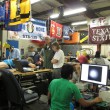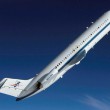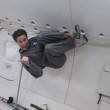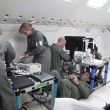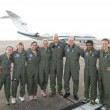As fun as weightlessness may appear to be, microgravity poses health challenges for astronauts. Eyes are among the organs affected, and some astronauts on long-duration missions are returning to Earth with permanent changes in their vision.
“It’s not just vision that’s altered. The structure of the eye changes,” says Jay Buckey, MD, a professor of medicine and head of the Space Medicine Innovations Lab at Geisel. “The eye’s a bit shorter and looks as though it’s been pushed from the back. This is something usually seen in people who have elevated pressure in the fluids surrounding the brain—a condition called idiopathic intercranial hypertension.”
Astronauts, however, don’t show any of the other signs of elevated pressure in the head and the reason for the flattening of the eyeball is mysterious. Though the vision change is not a major problem—it results in farsightedness and can be corrected with glasses—it can be permanent. What concerns Buckey is that it’s happening at all, and he’s driven to understand why. A former astronaut, Buckey flew in 1998 as a Payload Specialist aboard the Space Shuttle Columbia’s Neurolab Mission, and has written a textbook on space physiology and the adaptation to microgravity.
Buckey’s interdisciplinary “Space Eyes” team has been investigating the detrimental effect of microgravity on eyes for the past three years. In his lab at Geisel, they study the effects of changes in the direction of gravity on the eye by taking measurements from individuals in different body postures.

But studying the eye in weightlessness requires simulating space flight. And where better to experience microgravity than on a NASA C-9 aircraft that produces short periods of weightlessness during parabolic flight. This year the team, which includes Michael Zegans, MD, an ophthalmologist and professor of surgery at Geisel, traveled to Johnson Space Center in Houston, Texas to collect data in microgravity.
Performing the experiments required moving the lab’s equipment to Houston, qualifying it to fly on the aircraft, and training the team to make the microgravity measurements. Abigail Fellows, a research coordinator in the lab, and Allison Anderson, a post-doctoral fellow, transferred the lab to Ellington Field in Houston. There, the team gathered detailed baseline measurements and data from the test subjects in upright, supine, and prone positions both prior to and during parabolic flight. The researchers used a Spectralis Optical Coherence Tomography (OCT) device, and a Lenstar Optical Biometer to view the eye’s structure.
On the flights, Gautam Babu ‘16, a Dartmouth undergraduate, operated the OCT device during all four segments of microgravity. He recorded the thickness of the choroid, which assists in focusing the eye, along with the anterior chamber angles—an important structure for regulating eye pressure—of the test subjects. Babu and fellow Dartmouth undergraduate Helen Gu ‘18, who was also a test subject, collected data, ensured the equipment was operational for each flight, and taught test subjects what they needed to do during flight.
Experiencing microgravity for 20 seconds on each of the 40 daily parabolas was an experience like no other, Babu recalls. “It was exhilarating and satisfyingly tiring, but it was also gratifying when everyone worked together to overcome challenges,” he says. “It was great working together with the doctors, engineers, and students—seeing how we all made meaningful contributions.”
Back in the lab, the team is analyzing the data on how the thickness of the choroid, length of the eye, and pressure in the eye change in microgravity, and in different body postures. It’s tempting to wonder how data gathered after a mere 20 seconds of cumulative weightlessness contributes to understanding the affect of microgravity experienced by astronauts over several months.
Buckey’s answer: numerical modeling. A project goal is to develop a numerical model of the eye and of the vascular system of the head using the collected data. He is working with Creare, LLC, an engineering research and development company in Hanover, NH, to build the model, which will allow the Space Eyes team to develop hypotheses about what may be happening when astronauts experience weightlessness for long periods of time, and to help predict the unique effects gravity has on the eye.
“Numerical modeling will allow us to see which parts of the eye may be most sensitive to microgravity and be helpful in identifying astronauts who may be susceptible to visual changes,” Buckey says. “It can also lead to developing new countermeasures.”
For example, “In microgravity body fluids shift from the lower to upper body,” he explains. “If you relieve that fluid shift for a certain period of time during flight, you may be able to prevent vision changes from happening.”
Beyond averting vision alterations in astronauts, this research also has implications for those of us who remain Earthbound.
“The thing is, what happens with gravity is not just important for going into space. This is also important for people with clinical problems like glaucoma or elevated intracranial pressure. Also, some surgical procedures like spinal surgery put patients in the prone position for a long time—which can affect the eye,” Buckey notes.
“What I find fascinating about this is that people have been going into space for some time, but this problem has only been recently recognized,” he adds. “And the reason for the change is a complete mystery. It shows that we don’t really understand what affect gravity has on our eye or on the vascular system in our head. Figuring this out will give us a new understanding that will be useful not only for space flight, but for glaucoma, and other eye conditions.”

